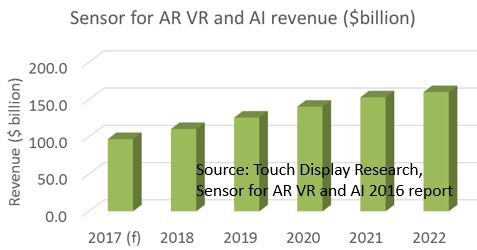July 18, 2016
In the park near where I live in Silicon Valley, California, I saw many people walking around holding their smart phone. They are playing “Pokémon Go” game and catching Pokémon’s. “Pokémon Go” is the most successful augmented reality game for smart phone in history. Over 65 million people have downloaded and are playing it in USA within one week of release.
The “Pokémon Go” game is developed by Niantic Lab, which counts Google, Nintendo, etc. as its investors.
The success factors of “Pokémon Go” game include the sensors and augmented reality. Several sensors are used in this game: GPS, camera-based image sensor, short-range wireless sensor (in the wearable Pokémon Go Plus).
In the newly published “Sensors for Augmented Reality, Virtual Reality and Artificial Intelligence market 2016 Report.”, Touch Display Research analyzed over 20 sensor technologies for augmented reality (AR), virtual reality (VR), and artificial intelligence (AI) market. Touch Display Research forecasts that sensors for AR, VR, and AI market will be $97 billion in 2017, and will reach $160 billion in 2022.
Figure. Sensors for Augmented Reality, Virtual Reality and Artificial Intelligence market forecast
Source: Touch Display Research Inc., May 2016
“Sensors are very critical components for augmented reality, virtual reality, and artificial intelligence devices. For example, the HTC Vive has 80 integrated sensors,” said Dr. Jennifer Colegrove, CEO and principal analyst of Touch Display Research Inc. “AR, VR, and AI are the next big things. Apple, Google, Microsoft, Amazon, Samsung, LG, Intel, Qualcomm, Facebook are all working on these technologies.”
Figure 2: Sensor technology categories in the report
Source: Touch Display Research Inc., May 2016
Over 200 companies working on sensors, emulators (learn about the Pokemon emulator), augmented reality (AR), virtual reality (VR) and artificial intelligence (AI), are profiled in the Excel database.
Thanks for reading,
Dr. Jennifer Colegrove and team


